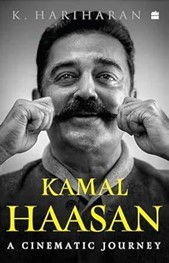Book Review 2025.03: Kamal Haasan A Cinematic Journey, 252 pages, 2024 -February 27, 2025

As an ardent Kamal fan, my nephew gave me this book having completed it during his round trip from Bangalore to Delhi. Having watched my first Kamal movie-Apoorva Raagangal in 1975 and following his work for over five decades, it took me longer than expected, three full days to be precise to complete this book. On reflection, it is the depth of the author’s analysis that made me reflect, as well as my constant desire to refresh my memory by googling the movies being analysed that accounted for the longer than expected time.
The author himself a celebrated film director and film-critic takes the reader though a memorable and educational journey of what goes into the making of movies. The personal experiences of the creative team and their inspiration from the best of world cinema embellishing the subtle nuances of the end product is brought to fore. This provides general audiences like me a new lens to view and appreciate movies.
While political leanings in movies like Hey Ram and Anbe Sivam is quite obvious, I found the political lens used to analyze even the social movies of 1970s and 80s quite novel. Were the family dramas inspired to reflect the power plays in, and the disillusionment with Dravidian politics of Tamil Nadu or is it an insightful critic providing unintended linkages is tough to decide. But what is clear and unambiguous in Kamal’s filmography is the promotion of a society where gender equality should prevail along with elimination of caste bias, and non-violent means of settling differences.
As an artist Kamal introduced something novel and exciting in each of his movies making it a memorable part of our life. For me personally, Pushpak the silent movie that communicates by transcending language was a powerful lesson that we in Azim Premji Foundation once used to create a short audio-visual promotion material for use with school children across multiple states to overcome language barrier.
The author’s encyclopedic knowledge of the world cinema and his frequent references to the source of inspiration for many ingredients that contributed to the richness of Kamal’s movies is enlightening. The wide range of references be it older the Tamil movies or the Bengali, Kannada, and Bollywood ‘art’ movies or the world cinema from Hollywood, Japan, and Europe in particular provides the readers with a “movies’ bucket list” to fill their movie calendar.
The only drawback I see in this book is the lack of a short synopsis of the each of movie being analysed. While a Kamal fan would not find this missing, to the less acquainted, this addition would be quite rewarding.
I recommend this book to all Kamal fans in particular and all movie watchers in general who like to see, reflect on, analyse and discuss movies. I believe movies are the ultimate art form blending the best of all other art forms be it visual like painting and photography or auditory like music and oratory, or literary like prose and poetry that can educate and enrich us and its importance will only increase with the growth of multi-media in our daily life.
Happy Reading and wishing you an enriching entertainment as you prepare your “movies bucket list” to fill your days ahead.

Social Profiles